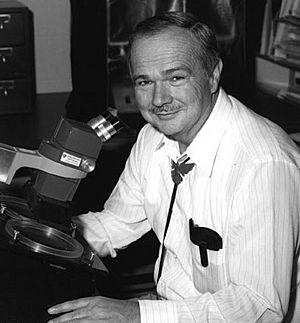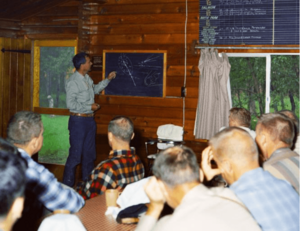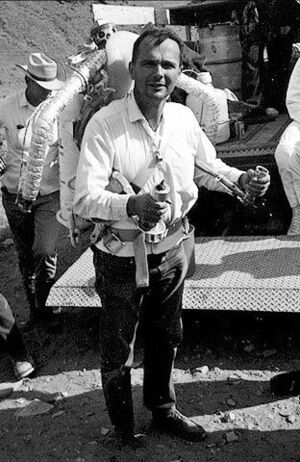Eugene Merle Shoemaker facts for kids
Quick facts for kids
Eugene Merle Shoemaker
|
|
|---|---|
 |
|
| Born | April 28, 1928 |
| Died | July 18, 1997 (aged 69) near Alice Springs, Australia
|
| Nationality | American |
| Alma mater | California Institute of Technology Princeton University |
| Known for | Planetary science Comet Shoemaker–Levy 9 |
| Spouse(s) | Carolyn S. Shoemaker (m. 1951) |
| Awards | G. K. Gilbert Award (1983) Barringer Medal (1984) National Medal of Science (1992) William Bowie Medal (1996) James Craig Watson Medal (1998) |
| Scientific career | |
| Fields | Planetary geology |
| Institutions | U.S. Geological Survey, California Institute of Technology |
| Thesis | Impact mechanics at Meteor Crater, Arizona. (1960) |
| Doctoral advisor | Harry Hammond Hess |
Eugene Merle Shoemaker (born April 28, 1928 – died July 18, 1997) was an American geologist. He is famous for helping discover Comet Shoemaker–Levy 9 with his wife, Carolyn S. Shoemaker, and David H. Levy. This amazing comet crashed into Jupiter in July 1994, and people all over the world watched it happen on TV!
Shoemaker also studied huge holes in the ground called craters. He looked at places like Meteor Crater in Arizona. With another scientist, Edward C. T. Chao, he proved that this crater was made by something hitting Earth, not by a volcano. He also started the United States Geological Survey's (USGS) Astrogeology Research Program. This program studies geology in space.
Sadly, Eugene Shoemaker died in a car accident in Australia while visiting a crater site. After he passed away, some of his ashes were sent to the Moon aboard the Lunar Prospector spacecraft. He is the only person whose remains have been placed on another celestial body.
Contents
Early Life and Education
Eugene Shoemaker was born in Los Angeles, California. His mom, Muriel May, was a teacher, and his dad, George Estel Shoemaker, worked many different jobs. As a kid, Gene's family moved around a lot. They lived in Los Angeles, New York City, Buffalo, New York, and Wyoming.
Gene's love for rocks started when he took science classes at the Buffalo Museum of Education. He began collecting minerals when he was in fourth grade. He even took high school classes in the evenings! When he was 13, his family moved back to Los Angeles. He finished high school in just three years. He also played the violin and was good at gymnastics.
At 16, Shoemaker went to the Caltech in 1944. He worked very hard and earned his first degree at 19. Then, he studied ancient rocks in New Mexico and got his master's degree in 1949.
Family Life
While at Caltech, Eugene met his future wife, Carolyn S. Shoemaker. She was the sister of his roommate. Carolyn wasn't very interested in science at first. She even found a geology class boring! But after meeting Gene, she said listening to him talk about geology made it exciting. They got married on August 17, 1951.
Eugene and Carolyn had three children. Carolyn focused on raising their kids. But once their children were grown, she wanted something new to do. Gene suggested she join his team to look for asteroids that might come close to Earth. Carolyn became a planetary astronomer at age 51 and discovered many asteroids and comets.
Discoveries and Contributions
In 1950, the United States Geological Survey (USGS) hired Shoemaker. His first job was to find uranium in Utah and Colorado. He then studied volcanoes, which led him to the Hopi Buttes volcanic field in Arizona, near Meteor Crater.
For a long time, scientists thought Meteor Crater was made by a volcano. But Eugene Shoemaker studied it for his Ph.D. degree. He noticed that Meteor Crater looked like holes made by atomic bomb tests. In 1960, he and Edward C. T. Chao found a special mineral called shocked quartz there. This proved the crater was formed by a powerful impact, not a volcano.
Exploring the Moon and Space

In 1960, Shoemaker led a team at the USGS to create the first geological map of the Moon. He also helped start the field of astrogeology, which is the study of planets and other space objects. He was a big part of the Ranger program missions, which took pictures of the Moon to prepare for human landings.
Shoemaker was also involved in the Apollo program. He helped train American astronauts for their Moon missions. He even trained them at Meteor Crater! He was supposed to be the first geologist to walk on the Moon, but he couldn't go because of a health condition. He became a TV commentator for CBS News during the early Apollo missions, explaining what was happening to people watching at home.
Later, he started looking for asteroids that cross Earth's orbit. He found many of these "Apollo asteroids." Shoemaker believed that asteroid impacts could cause big changes on Earth and that these impacts happen often over long periods of time.
Comet Shoemaker–Levy 9
In 1993, Eugene Shoemaker, his wife Carolyn, and David H. Levy discovered Comet Shoemaker–Levy 9. They used a special telescope at Palomar Observatory. This comet was very special because it was the first time scientists could watch a comet hit a planet. In July 1994, the comet crashed into Jupiter, leaving a huge "scar" on the planet's surface.
Death and Legacy
Eugene Shoemaker spent his later years searching for new impact craters around the world. He died on July 18, 1997, in a car accident in Australia while on one of these expeditions. His wife, Carolyn, was seriously hurt in the crash.
On July 31, 1999, some of his ashes were sent to the Moon aboard the Lunar Prospector spacecraft. This was a special tribute to him. He is the only person whose remains have been placed on another celestial body outside Earth.
Many things have been named in honor of Eugene Shoemaker:
- A crater in Western Australia was renamed "Shoemaker crater".
- The Near Earth Asteroid Rendezvous space probe was renamed "NEAR Shoemaker". It landed on the asteroid 433 Eros in 2000.
- An asteroid, 2074 Shoemaker, was named after him by a colleague.
- The Finnish band Nightwish even wrote a song called "Shoemaker" in his honor!
Awards and Honors
Eugene Shoemaker received many awards for his important work. Some of them include:
- Doctorate of Science from Arizona State College (1965)
- John Price Wetherill Medal (1965)
- NASA Medal for Scientific Achievement (1967)
- Member of the U.S. National Academy of Sciences (1980)
- G.K. Gilbert Award (1983)
- Barringer Medal (1984)
- Gerard P. Kuiper Prize (1984)
- National Medal of Science (1992)
- William Bowie Medal (1996)
- NASA Exceptional Scientific Achievement Medal (1996)
Asteroids Discovered
Eugene Shoemaker is credited with helping discover 183 minor planets (asteroids) between 1977 and 1994.
| List of minor planets discovered by Eugene Shoemaker | ||||||||||||||||||||||||||||||||||||||||||||||||||||||||||||||||||||||||||||||||||||||||||||||||||||||||||||||||||||||||||||||||||||||||||||||||||||||||||||||||||||||||||||||||||||||||||||||||||||||||||||||||||||||||||||||||||||||||||||||||||||||||||||||||||||||||||||||||||||||||||||||||||||||||||||||||||||||||||||||||||||||||||||||||||||||||||||||||||||||||||||||||||||||||||||||||||||||||||||||||||||||||||||||||||||||||||||||||||||||||||||||||||||||||||||||||||||||||||||||||||||||||||||||||||||||||||||||||||||||||||||||||||||||||||||||||||||||||||||||
|---|---|---|---|---|---|---|---|---|---|---|---|---|---|---|---|---|---|---|---|---|---|---|---|---|---|---|---|---|---|---|---|---|---|---|---|---|---|---|---|---|---|---|---|---|---|---|---|---|---|---|---|---|---|---|---|---|---|---|---|---|---|---|---|---|---|---|---|---|---|---|---|---|---|---|---|---|---|---|---|---|---|---|---|---|---|---|---|---|---|---|---|---|---|---|---|---|---|---|---|---|---|---|---|---|---|---|---|---|---|---|---|---|---|---|---|---|---|---|---|---|---|---|---|---|---|---|---|---|---|---|---|---|---|---|---|---|---|---|---|---|---|---|---|---|---|---|---|---|---|---|---|---|---|---|---|---|---|---|---|---|---|---|---|---|---|---|---|---|---|---|---|---|---|---|---|---|---|---|---|---|---|---|---|---|---|---|---|---|---|---|---|---|---|---|---|---|---|---|---|---|---|---|---|---|---|---|---|---|---|---|---|---|---|---|---|---|---|---|---|---|---|---|---|---|---|---|---|---|---|---|---|---|---|---|---|---|---|---|---|---|---|---|---|---|---|---|---|---|---|---|---|---|---|---|---|---|---|---|---|---|---|---|---|---|---|---|---|---|---|---|---|---|---|---|---|---|---|---|---|---|---|---|---|---|---|---|---|---|---|---|---|---|---|---|---|---|---|---|---|---|---|---|---|---|---|---|---|---|---|---|---|---|---|---|---|---|---|---|---|---|---|---|---|---|---|---|---|---|---|---|---|---|---|---|---|---|---|---|---|---|---|---|---|---|---|---|---|---|---|---|---|---|---|---|---|---|---|---|---|---|---|---|---|---|---|---|---|---|---|---|---|---|---|---|---|---|---|---|---|---|---|---|---|---|---|---|---|---|---|---|---|---|---|---|---|---|---|---|---|---|---|---|---|---|---|---|---|---|---|---|---|---|---|---|---|---|---|---|---|---|---|---|---|---|---|---|---|---|---|---|---|---|---|---|---|---|---|---|---|---|---|---|---|---|---|---|---|---|---|---|---|---|---|---|---|---|---|---|---|---|---|---|---|---|---|---|---|---|---|---|---|---|---|---|---|---|---|---|---|---|---|---|---|---|---|---|---|---|---|---|---|---|---|---|---|---|---|---|---|---|---|---|---|---|---|---|---|---|---|---|---|---|---|---|---|---|---|---|---|---|---|---|---|---|---|---|---|---|---|---|---|---|---|---|---|---|---|---|---|---|---|---|---|---|---|---|---|---|---|---|---|---|---|---|---|---|---|---|
|
||||||||||||||||||||||||||||||||||||||||||||||||||||||||||||||||||||||||||||||||||||||||||||||||||||||||||||||||||||||||||||||||||||||||||||||||||||||||||||||||||||||||||||||||||||||||||||||||||||||||||||||||||||||||||||||||||||||||||||||||||||||||||||||||||||||||||||||||||||||||||||||||||||||||||||||||||||||||||||||||||||||||||||||||||||||||||||||||||||||||||||||||||||||||||||||||||||||||||||||||||||||||||||||||||||||||||||||||||||||||||||||||||||||||||||||||||||||||||||||||||||||||||||||||||||||||||||||||||||||||||||||||||||||||||||||||||||||||||||||
See also
 In Spanish: Eugene Shoemaker para niños
In Spanish: Eugene Shoemaker para niños


